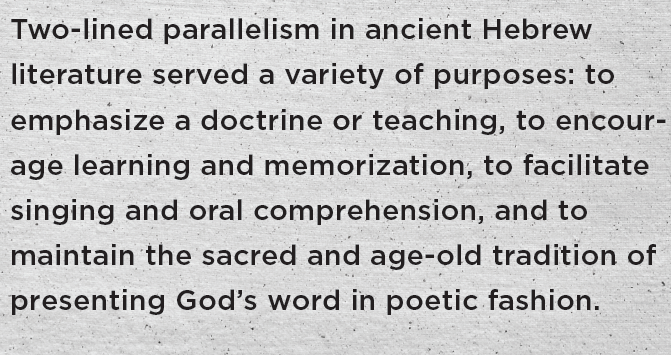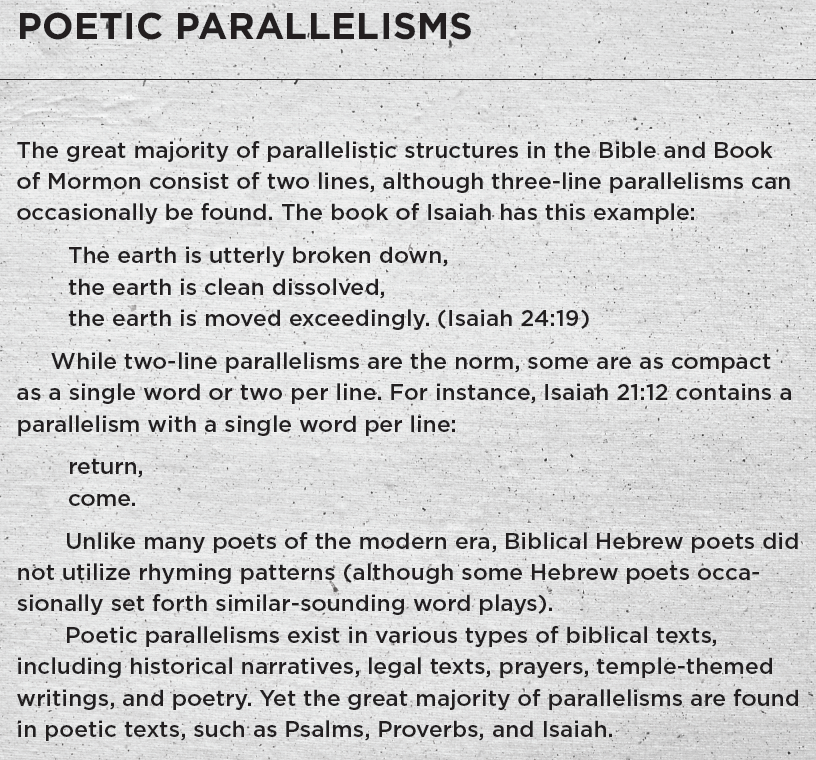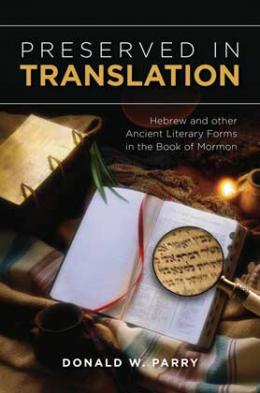Coordinating Parallelism
Donald W. Perry, “Coordinating Parallelism,” in Preserved in Translation: Hebrew and Other Ancient Literary Forms in the Book of Mormon (Provo, UT: Religious Studies Center, Brigham Young University; Salt Lake City: Deseret Book), 23‒26.
"Adam fell that men might be, . . . might have joy" (2 Nephi 2:25)
Coordinating parallelism, another characteristic of ancient Hebrew literature, is composed of two lines, with the second line providing an explanation of, or adding instruction to, the first.[1] It is called coordinating because it involves a coordination between the elements of the two lines. First the idea is introduced, and then it is realized or completed. The specific realization in the second line is often unexpected. This kind of parallelism may be found in virtually any type of literature—proverbial sayings, larger poetic sections, prophecies, epistles, and historical narratives.

Psalm 19:7–9 presents six instances of coordinating parallelism, one after another. Note how in each case the first line states an important truth and the second line adds further truth or insight.
The law of the Lord is perfect,
converting the soul:
The testimony of the Lord is sure,
making wise the simple.
The statutes of the Lord are right,
rejoicing the heart:
The commandment of the Lord is pure,
enlightening the eyes.
The fear of the Lord is clean,
enduring for ever:
The judgments of the Lord are true
and righteous altogether.
The Book of Mormon includes several examples of coordinating parallelism.[2] Here is one well-known example:
Adam fell that men might be;
and men are, that they might have joy. (2 Nephi 2:25)
The first line, while complete in itself, is followed by an additional teaching in the second line.

Second Nephi 9:31–38 has eight separate examples of coordinating parallelism, with each beginning line followed by an explanation in the following line:
And wo unto the deaf that will not hear;
for they shall perish.
Wo unto the blind that will not see;
for they shall perish also.
Wo unto the uncircumcised of heart,
for a knowledge of their iniquities shall smite them at the last day.
Wo unto the liar,
for he shall be thrust down to hell.
Wo unto the murderer who deliberately killeth,
for he shall die.
Wo unto them who commit whoredoms,
for they shall be thrust down to hell.
Yea, wo unto those that worship idols,
for the devil of all devils delighteth in them.
And, in fine, wo unto all those who die in their sins;
for they shall return to God, and behold his face, and remain in their sins.
Note that the first line of each parallelism opens with the interjection wo (or and wo), followed by the reason for the great distress and sorrow: wo to the deaf (spiritually deaf), to the blind (spiritually blind), to the uncircumcised (spiritually uncircumcised), to the liar, and so forth.
Each second line of the eight parallelisms above begins with for, having the sense of “because.” This line generally explains what happens to those who have been characterized as being spiritually unregenerate—they will perish, be smitten, be thrust down to hell, and so forth. As can be seen, coordinating parallelisms, like other types of parallelism, can effectively convey much religious truth in graceful, compact form.
The great majority of parallelistic structures in the Bible and Book of Mormon consist of two lines, although three-line parallelisms can occasionally be found. The book of Isaiah has this example:
The earth is utterly broken down,
the earth is clean dissolved,
the earth is moved exceedingly. (24:19)
While two-line parallelisms are the norm, some are as compact as a single word or two per line. For instance, Isaiah 21:12 contains a parallelism with a single word per line:
return,
come.
Unlike many poets of the modern era, Biblical Hebrew poets did not utilize rhyming patterns (although some Hebrew poets occasionally set forth similar-sounding word plays).
Poetic parallelisms exist in various types of biblical text, including historical narratives, legal texts, prayers, temple-themed writings, and poetry. Yet the great majority of parallelisms are found in poetic texts, such as Psalms, Proverbs, and Isaiah.
Notes
[1] For a definition of coordinating (or synthetic) parallelism, see Ridderbos and Wolf, “Hebrew Poetry,” 3:893.
[2] For a brief treatment of coordinating parallelism in Book of Mormon, see Parry, Poetic Parallelisms in the Book of Mormon, xxiv, xxiv–xxvi, 567.
